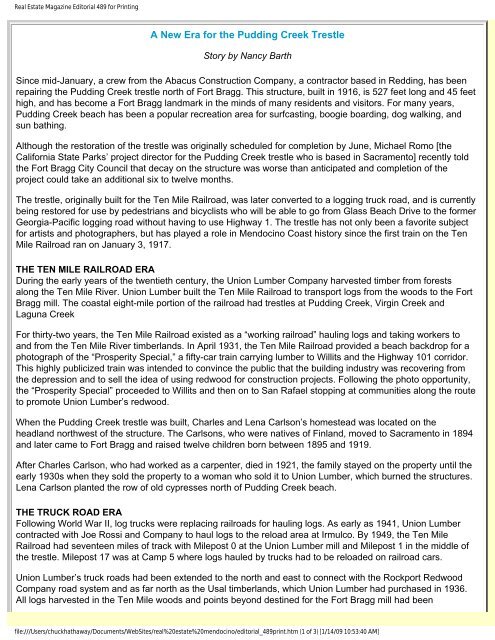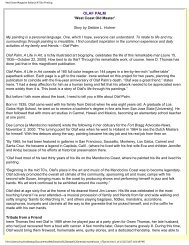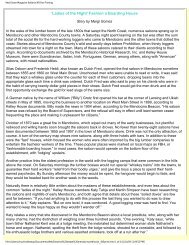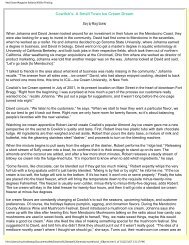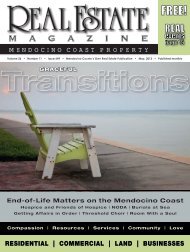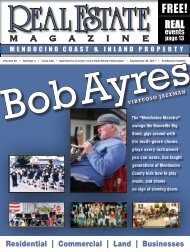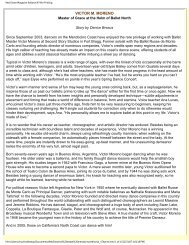A New Era for the Pudding Creek Trestle - Real Estate Magazine
A New Era for the Pudding Creek Trestle - Real Estate Magazine
A New Era for the Pudding Creek Trestle - Real Estate Magazine
You also want an ePaper? Increase the reach of your titles
YUMPU automatically turns print PDFs into web optimized ePapers that Google loves.
<strong>Real</strong> <strong>Estate</strong> <strong>Magazine</strong> Editorial 489 <strong>for</strong> Printing<br />
A <strong>New</strong> <strong>Era</strong> <strong>for</strong> <strong>the</strong> <strong>Pudding</strong> <strong>Creek</strong> <strong>Trestle</strong><br />
Story by Nancy Barth<br />
Since mid-January, a crew from <strong>the</strong> Abacus Construction Company, a contractor based in Redding, has been<br />
repairing <strong>the</strong> <strong>Pudding</strong> <strong>Creek</strong> trestle north of Fort Bragg. This structure, built in 1916, is 527 feet long and 45 feet<br />
high, and has become a Fort Bragg landmark in <strong>the</strong> minds of many residents and visitors. For many years,<br />
<strong>Pudding</strong> <strong>Creek</strong> beach has been a popular recreation area <strong>for</strong> surfcasting, boogie boarding, dog walking, and<br />
sun bathing.<br />
Although <strong>the</strong> restoration of <strong>the</strong> trestle was originally scheduled <strong>for</strong> completion by June, Michael Romo [<strong>the</strong><br />
Cali<strong>for</strong>nia State Parks’ project director <strong>for</strong> <strong>the</strong> <strong>Pudding</strong> <strong>Creek</strong> trestle who is based in Sacramento] recently told<br />
<strong>the</strong> Fort Bragg City Council that decay on <strong>the</strong> structure was worse than anticipated and completion of <strong>the</strong><br />
project could take an additional six to twelve months.<br />
The trestle, originally built <strong>for</strong> <strong>the</strong> Ten Mile Railroad, was later converted to a logging truck road, and is currently<br />
being restored <strong>for</strong> use by pedestrians and bicyclists who will be able to go from Glass Beach Drive to <strong>the</strong> <strong>for</strong>mer<br />
Georgia-Pacific logging road without having to use Highway 1. The trestle has not only been a favorite subject<br />
<strong>for</strong> artists and photographers, but has played a role in Mendocino Coast history since <strong>the</strong> first train on <strong>the</strong> Ten<br />
Mile Railroad ran on January 3, 1917.<br />
THE TEN MILE RAILROAD ERA<br />
During <strong>the</strong> early years of <strong>the</strong> twentieth century, <strong>the</strong> Union Lumber Company harvested timber from <strong>for</strong>ests<br />
along <strong>the</strong> Ten Mile River. Union Lumber built <strong>the</strong> Ten Mile Railroad to transport logs from <strong>the</strong> woods to <strong>the</strong> Fort<br />
Bragg mill. The coastal eight-mile portion of <strong>the</strong> railroad had trestles at <strong>Pudding</strong> <strong>Creek</strong>, Virgin <strong>Creek</strong> and<br />
Laguna <strong>Creek</strong><br />
For thirty-two years, <strong>the</strong> Ten Mile Railroad existed as a “working railroad” hauling logs and taking workers to<br />
and from <strong>the</strong> Ten Mile River timberlands. In April 1931, <strong>the</strong> Ten Mile Railroad provided a beach backdrop <strong>for</strong> a<br />
photograph of <strong>the</strong> “Prosperity Special,” a fifty-car train carrying lumber to Willits and <strong>the</strong> Highway 101 corridor.<br />
This highly publicized train was intended to convince <strong>the</strong> public that <strong>the</strong> building industry was recovering from<br />
<strong>the</strong> depression and to sell <strong>the</strong> idea of using redwood <strong>for</strong> construction projects. Following <strong>the</strong> photo opportunity,<br />
<strong>the</strong> “Prosperity Special” proceeded to Willits and <strong>the</strong>n on to San Rafael stopping at communities along <strong>the</strong> route<br />
to promote Union Lumber’s redwood.<br />
When <strong>the</strong> <strong>Pudding</strong> <strong>Creek</strong> trestle was built, Charles and Lena Carlson’s homestead was located on <strong>the</strong><br />
headland northwest of <strong>the</strong> structure. The Carlsons, who were natives of Finland, moved to Sacramento in 1894<br />
and later came to Fort Bragg and raised twelve children born between 1895 and 1919.<br />
After Charles Carlson, who had worked as a carpenter, died in 1921, <strong>the</strong> family stayed on <strong>the</strong> property until <strong>the</strong><br />
early 1930s when <strong>the</strong>y sold <strong>the</strong> property to a woman who sold it to Union Lumber, which burned <strong>the</strong> structures.<br />
Lena Carlson planted <strong>the</strong> row of old cypresses north of <strong>Pudding</strong> <strong>Creek</strong> beach.<br />
THE TRUCK ROAD ERA<br />
Following World War II, log trucks were replacing railroads <strong>for</strong> hauling logs. As early as 1941, Union Lumber<br />
contracted with Joe Rossi and Company to haul logs to <strong>the</strong> reload area at Irmulco. By 1949, <strong>the</strong> Ten Mile<br />
Railroad had seventeen miles of track with Milepost 0 at <strong>the</strong> Union Lumber mill and Milepost 1 in <strong>the</strong> middle of<br />
<strong>the</strong> trestle. Milepost 17 was at Camp 5 where logs hauled by trucks had to be reloaded on railroad cars.<br />
Union Lumber’s truck roads had been extended to <strong>the</strong> north and east to connect with <strong>the</strong> Rockport Redwood<br />
Company road system and as far north as <strong>the</strong> Usal timberlands, which Union Lumber had purchased in 1936.<br />
All logs harvested in <strong>the</strong> Ten Mile woods and points beyond destined <strong>for</strong> <strong>the</strong> Fort Bragg mill had been<br />
file:///Users/chuckhathaway/Documents/WebSites/real%20estate%20mendocino/editorial_489print.htm (1 of 3) [1/14/09 10:53:40 AM]
<strong>Real</strong> <strong>Estate</strong> <strong>Magazine</strong> Editorial 489 <strong>for</strong> Printing<br />
transferred from trucks to railroad cars. Logic dictated that Union Lumber convert <strong>the</strong> railroad route into a truck<br />
road. On June 17, 1949, <strong>the</strong> Ten Mile Railroad ran a final excursion <strong>for</strong> one hundred Fort Bragg residents to<br />
witness <strong>the</strong> loading of <strong>the</strong> last logging train at Camp 2 along <strong>the</strong> Ten Mile River.<br />
Although <strong>the</strong> roadbed had been prepared in advance, <strong>the</strong> final conversion from railroad to truck road was<br />
completed in two days utilizing a device, pulled by a locomotive, which pulled up <strong>the</strong> rails. Because <strong>the</strong> offhighway<br />
trucks, which would use <strong>the</strong> road to haul old growth logs, were wider and heavier than <strong>the</strong> railroad<br />
cars, <strong>the</strong> <strong>Pudding</strong> <strong>Creek</strong> trestle’s structure was rein<strong>for</strong>ced and <strong>the</strong> deck was widened.<br />
After <strong>the</strong> railroad tracks, and ninety-six thousand ties were removed and hauled away, <strong>the</strong> road was leveled<br />
and prepared <strong>for</strong> <strong>the</strong> trucks to haul logs in July, 1949. After <strong>the</strong> conversion, Union Lumber contracted with Joe<br />
J. Rossi and Company to haul logs using 1949 Kenworth 524 off-highway diesel-powered trucks. In 1956,<br />
Union Lumber bought five of <strong>the</strong> trucks from Joe J. Rossi.<br />
Of <strong>the</strong> nineteen off-highway trucks owned by Union Lumber, No. 11, a 1958 Kenworth, was transferred to <strong>the</strong><br />
Roots of Motive Power [an all-volunteer organization founded in 1982 to preserve and restore steam- and<br />
diesel-powered equipment used in Cali<strong>for</strong>nia north coast logging industry from <strong>the</strong> 1850s to <strong>the</strong> present]. In<br />
May 1998, No. 11 took its final drive over Highway 20 from Fort Bragg and now can be seen at Roots of Motive<br />
Power located on East Commercial Street in Willits just east of <strong>the</strong> county museum.<br />
In January 1952, Union Lumber closed <strong>the</strong> dining room and bachelor cabins of Camp 2, <strong>the</strong> last remaining<br />
camp in <strong>the</strong> Ten Mile woods. Most employees preferred to live in Fort Bragg instead of in <strong>the</strong> remote camps.<br />
The <strong>Pudding</strong> <strong>Creek</strong> trestle was <strong>the</strong> site of a tragedy on <strong>the</strong> night of February 7, 1952, when an automobile<br />
jumped <strong>the</strong> guard rail and plunged <strong>for</strong>ty-five feet down to <strong>the</strong> beach. All three occupants of <strong>the</strong> car died be<strong>for</strong>e<br />
<strong>the</strong> accident was discovered <strong>the</strong> next morning.<br />
In 1969 <strong>the</strong> Union Lumber Company was purchased by Boise-Cascade, which sold <strong>the</strong> mill to Georgia-Pacific<br />
in 1973. In 1976, Georgia-Pacific did <strong>the</strong> first major repair of <strong>the</strong> <strong>Pudding</strong> <strong>Creek</strong> trestle in many years using<br />
cranes from <strong>the</strong> woods operation to replace planks, ties, stringers, sway braces and pilings.<br />
Vehicle traffic on <strong>the</strong> Ten Mile beach portion of Georgia-Pacific’s logging road came to an end on February 16,<br />
1983 after high waves from a winter storm washed out twenty feet of <strong>the</strong> road a quarter of a mile north of <strong>the</strong><br />
Ward Avenue access. The same storm damaged Point Cabrillo Drive near Caspar beach and destroyed Point<br />
Arena’s fishing pier. Subsequent storms caused increased damage and washed out a detour being constructed<br />
by Georgia-Pacific. Finally, Georgia-Pacific applied <strong>for</strong> a permit to develop a bypass east of <strong>the</strong> damaged<br />
portion of <strong>the</strong> road on state park property, but <strong>the</strong> approved permit gave Georgia-Pacific use of <strong>the</strong> road only<br />
until 1990.<br />
While <strong>the</strong> debate over repair of <strong>the</strong> logging road was going on during <strong>the</strong> summer of 1983, <strong>the</strong> <strong>Pudding</strong> <strong>Creek</strong><br />
trestle had some unusual visitors. Early in August, a herd of nine female Roosevelt elk came as far south as<br />
<strong>Pudding</strong> <strong>Creek</strong> be<strong>for</strong>e heading back north to <strong>the</strong> Ten Mile River. Several of <strong>the</strong> elk had radio collars, which had<br />
been installed in <strong>the</strong> King Range, where <strong>the</strong>y had been relocated from Prairie <strong>Creek</strong> Redwoods State Park.<br />
The elk were on Ten Mile beach heading north when <strong>the</strong> Cali<strong>for</strong>nia Department of Fish and Game attempted to<br />
capture <strong>the</strong>m using tranquilizer darts. Four were tranquilized and returned to <strong>the</strong> King Range but one had an<br />
adverse reaction to <strong>the</strong> tranquilizer and drowned in <strong>the</strong> ocean. The o<strong>the</strong>r four elk escaped to pasture lands east<br />
of <strong>the</strong> Ten Mile River bridge and lived <strong>the</strong>re among <strong>the</strong> cattle until a few years ago when <strong>the</strong>y succumbed to old<br />
age. Elk had lived on <strong>the</strong> Mendocino Coast in <strong>the</strong> past, but a historical document claimed that <strong>the</strong> last coastal<br />
Roosevelt elk was killed north of Ten Mile in 1878.<br />
After lengthy negotiations, Cali<strong>for</strong>nia State Parks purchased <strong>the</strong> unused logging road and <strong>the</strong> headlands<br />
northwest of <strong>the</strong> trestle in 1995. State Parks Mendocino District Superintendent Bill Berry and his successor,<br />
Greg Picard, both strongly supported restoration of <strong>the</strong> trestle <strong>for</strong> pedestrians and bicyclists. [Currently <strong>the</strong><br />
acting superintendent is Kirk Marshall; <strong>the</strong> position is expected to be filled in June of this year.]<br />
file:///Users/chuckhathaway/Documents/WebSites/real%20estate%20mendocino/editorial_489print.htm (2 of 3) [1/14/09 10:53:40 AM]
<strong>Real</strong> <strong>Estate</strong> <strong>Magazine</strong> Editorial 489 <strong>for</strong> Printing<br />
Bill Berry’s stay on <strong>the</strong> coast did not start smoothly. His first act as district superintendent was to evict long-term<br />
campers from Navarro beach. Then he called a meeting of local people in Cleone to sound <strong>the</strong>m out about<br />
closing <strong>the</strong> access at Mill <strong>Creek</strong> Drive. The result was a major confrontation. From <strong>the</strong>n on, Bill Berry focused<br />
on <strong>the</strong> coastal trail and frequently led hikes through <strong>the</strong> dunes. When Bill Berry left in 1998, he had a large<br />
following of local friends.<br />
Greg Picard came to <strong>the</strong> Mendocino district from Cuyamaca State Park in <strong>the</strong> mountains east of San Diego.<br />
Greg had <strong>the</strong> luck to come to <strong>the</strong> Mendocino Coast in February 1998, just in time <strong>for</strong> El Niño’s heavy storms,<br />
which damaged coastal trails. Be<strong>for</strong>e his retirement [in <strong>the</strong> fall of 2003] Greg wea<strong>the</strong>red controversy about what<br />
uses would be allowed in <strong>the</strong> Ten Mile dunes and how to make recreation compatible with habitat preservation.<br />
Greg Picard was a strong supporter of restoring <strong>the</strong> <strong>Pudding</strong> <strong>Creek</strong> trestle.<br />
The trestle project also received vital support from <strong>the</strong> Fort Bragg City Council, <strong>the</strong> Mendocino County Board of<br />
Supervisors, State Senator Wes Chesbro, Assemblywoman Virginia Strom-Martin and Assemblywoman Patty<br />
Berg.<br />
RESTORATION IN PROGRESS<br />
Because <strong>the</strong> trestle had not been used since 1983 and had not had major repairs since 1976, extensive work is<br />
needed to replace rotten and damaged wood. Some of <strong>the</strong> pilings are wet much of <strong>the</strong> time and are battered by<br />
winter’s high water, storm tides and rogue waves. The abutments, which support <strong>the</strong> trestle’s weight at each<br />
end, are damp several months each year.<br />
The Abacus crew started <strong>the</strong> project by constructing a temporary guardrail <strong>for</strong> worker safety, and <strong>the</strong>n began<br />
replacing fender planks on <strong>the</strong> bottom of <strong>the</strong> trestle. The fenders add stability to <strong>the</strong> structure and deflect<br />
floating logs and debris which comes down <strong>Pudding</strong> <strong>Creek</strong> after heavy rains.<br />
At <strong>the</strong> same time, Abacus workers were preparing <strong>the</strong> south bluff <strong>for</strong> replacement of <strong>the</strong> abutment. First, <strong>the</strong><br />
remains of <strong>the</strong> old abutment were removed with a backhoe, and <strong>the</strong>n <strong>the</strong> workers constructed <strong>for</strong>ms <strong>for</strong> pouring<br />
cement <strong>for</strong> <strong>the</strong> new structure. Workers have also been on scaffolds replacing diagonal sway braces with new<br />
planks. The structural work is necessary because <strong>the</strong> trestle will have to support heavy equipment when <strong>the</strong><br />
deck is replaced.<br />
At this time, <strong>the</strong> date <strong>for</strong> completion is unknown but <strong>the</strong> opening is certain to be a major event <strong>for</strong> Fort Bragg.<br />
THANK YOU to Morgan Zeitler of Cali<strong>for</strong>nia State Parks <strong>for</strong> his cooperation, to Gene Lewis <strong>for</strong> sharing his<br />
historical and technical knowledge, and to all <strong>the</strong> Abacus workers who answered my questions about <strong>the</strong><br />
project.<br />
Return To Cover Selection Page Click Here<br />
file:///Users/chuckhathaway/Documents/WebSites/real%20estate%20mendocino/editorial_489print.htm (3 of 3) [1/14/09 10:53:40 AM]


